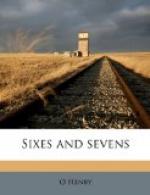You wonder again why it was named Lakelands. There are no lakes, and the lands about are too poor to be worth mentioning.
Half a mile from the village stands the Eagle House, a big, roomy old mansion run by Josiah Rankin for the accommodation of visitors who desire the mountain air at inexpensive rates. The Eagle House is delightfully mismanaged. It is full of ancient instead of modern improvements, and it is altogether as comfortably neglected and pleasingly disarranged as your own home. But you are furnished with clean rooms and good and abundant fare: yourself and the piny woods must do the rest. Nature has provided a mineral spring, grape-vine swings, and croquet—even the wickets are wooden. You have Art to thank only for the fiddle-and-guitar music twice a week at the hop in the rustic pavilion.
The patrons of the Eagle House are those who seek recreation as a necessity, as well as a pleasure. They are busy people, who may be likened to clocks that need a fortnight’s winding to insure a year’s running of their wheels. You will find students there from the lower towns, now and then an artist, or a geologist absorbed in construing the ancient strata of the hills. A few quiet families spend the summers there; and often one or two tired members of that patient sisterhood known to Lakelands as “schoolmarms.”
A quarter of a mile from the Eagle House was what would have been described to its guests as “an object of interest” in the catalogue, had the Eagle House issued a catalogue. This was an old, old mill that was no longer a mill. In the words of Josiah Rankin, it was “the only church in the United States, sah, with an overshot-wheel; and the only mill in the world, sah, with pews and a pipe organ.” The guests of the Eagle House attended the old mill church each Sabbath, and heard the preacher liken the purified Christian to bolted flour ground to usefulness between the millstones of experience and suffering.
Every year about the beginning of autumn there came to the Eagle House one Abram Strong, who remained for a time an honoured and beloved guest. In Lakelands he was called “Father Abram,” because his hair was so white, his face so strong and kind and florid, his laugh so merry, and his black clothes and broad hat so priestly in appearance. Even new guests after three or four days’ acquaintance gave him this familiar title.
Father Abram came a long way to Lakelands. He lived in a big, roaring town in the Northwest where he owned mills, not little mills with pews and an organ in them, but great, ugly, mountain-like mills that the freight trains crawled around all day like ants around an ant-heap. And now you must be told about Father Abram and the mill that was a church, for their stories run together.
In the days when the church was a mill, Mr. Strong was the miller. There was no jollier, dustier, busier, happier miller in all the land than he. He lived in a little cottage across the road from the mill. His hand was heavy, but his toll was light, and the mountaineers brought their grain to him across many weary miles of rocky roads.




